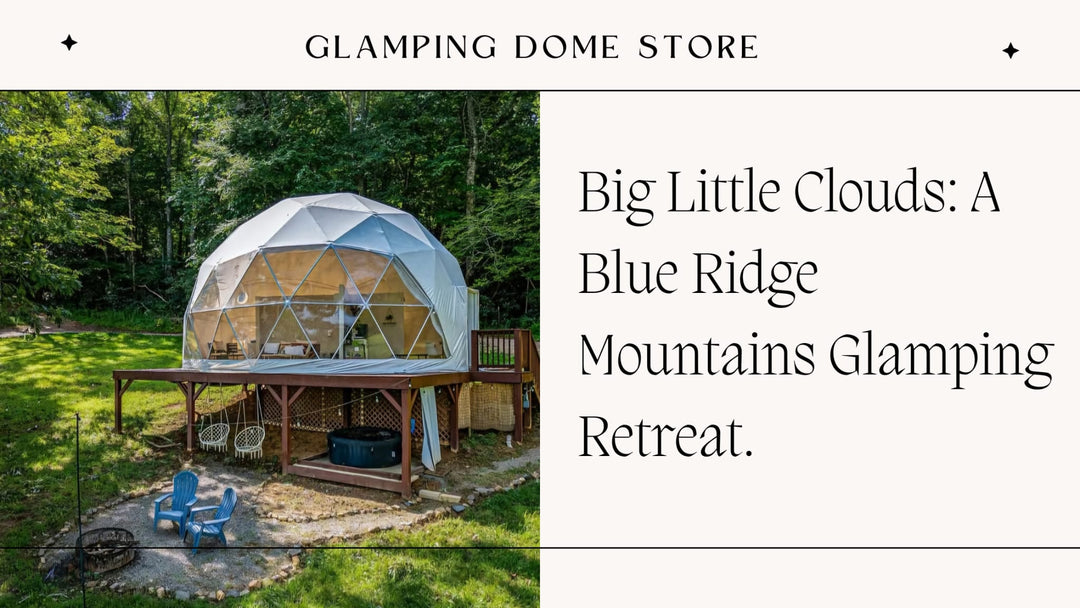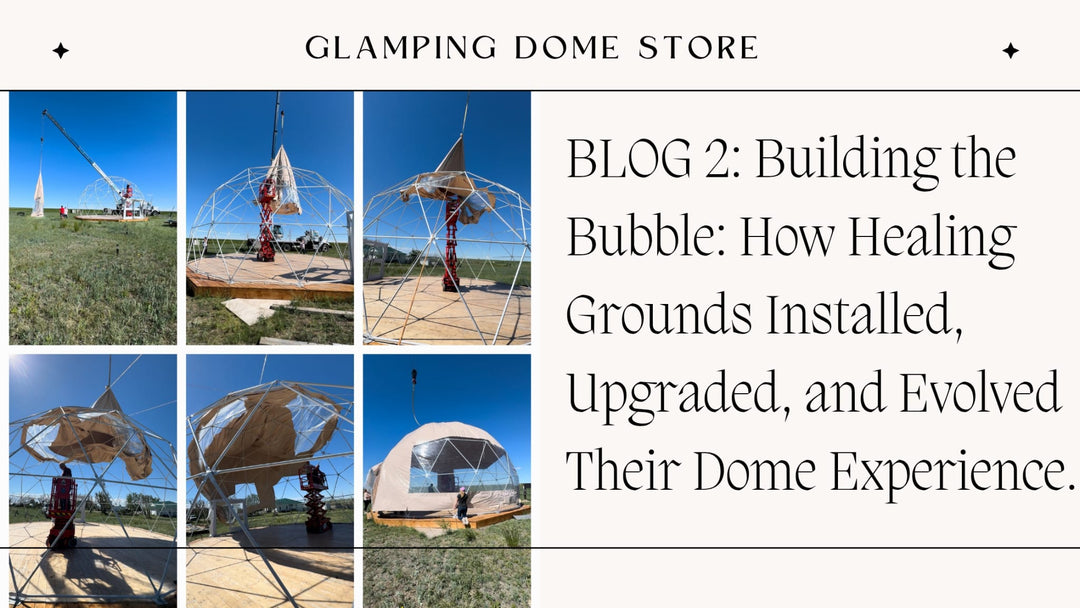Practical ways to keep nearby trees healthy while protecting your geodesic dome tent from damage.
Dome Tent Protection: Tree Care Tips for Glamping and Dome Living.
Protect your geodesic dome structure - whether it’s your retreat, rental, or full-time home.
Living in or hosting with a geodesic dome tent means getting closer to nature, but with that beauty comes responsibility. For comfort and longevity, it's often recommended to install dome structures in shaded areas to reduce the heat buildup on sunny days. Trees offer natural shade, privacy, and a serene environment, but without proper maintenance, they can pose serious risks to your dome’s structure and safety.
 Image 1. This dome in Wimberley, Texas, USA, benefits from natural shade, but healthy tree maintenance is key to keeping both comfort and safety in balance.
Image 1. This dome in Wimberley, Texas, USA, benefits from natural shade, but healthy tree maintenance is key to keeping both comfort and safety in balance.
Whether you're operating a glamping site, hosting guests on Airbnb, or living full-time in a dome home, here’s why routine tree care matters and how to make it part of your seasonal checklist.
Why It Matters. Even a single mid-sized branch can puncture your dome’s PVC membrane or shift its frame, causing costly damage or long-term downtime. Wind, snow, and ice can break limbs, even on healthy trees. A little attention goes a long way in avoiding major repairs.
Tree Care Essentials for Dome Owners.
● Monthly Canopy Walk-Arounds. Walk your site or property once a month and visually inspect all surrounding trees. Look for cracked, dead, or overhanging limbs, especially above or near the dome.
● Post-Storm Check-ins. After high winds, snowstorms, or freezing rain, revisit the trees around your dome tent. Healthy branches can weaken during extreme weather without obvious signs at first glance.
● Prune or Remove Weak Limbs. Don’t wait for nature to drop them. Prune or hire help to remove limbs before they become a problem. Proactive work is safer and cheaper.
● Annual Arborist Visit (Highly Recommended). For dome homes or mature sites, bring in a certified arborist once a year to assess the health and risk level of nearby trees. They can spot hidden rot, disease, or structural weakness.
● Smart Tree Planting (For Dome Owners and Hosts Expanding Their Site). When adding new trees near your dome tent, choose species known for strong limb structure and avoid tight branch angles. These are narrow angles, usually less than 45 degrees, between the trunk and branches that create weak attachment points. Under stress from wind, snow, or even the tree’s own weight, these limbs are more likely to break. In contrast, wider branch angles (closer to 60 degrees or more) provide stronger, more stable growth. By selecting the right tree types and ensuring branches grow out at healthier angles, you help prevent future limb failures that could damage your dome. Also, be sure to plant far enough from the dome structure to allow full canopy growth without crowding or overhead risk.
 Image 2. Tucked into the lush woods of Augusta, West Virginia, this dome tent sits elevated among the trees, proof that with proper site prep and tree care, you can create a private, elevated retreat that blends naturally with the forest canopy.
Image 2. Tucked into the lush woods of Augusta, West Virginia, this dome tent sits elevated among the trees, proof that with proper site prep and tree care, you can create a private, elevated retreat that blends naturally with the forest canopy.
Why Homeowners Especially Shouldn’t Skip Tree Maintenance.
For dome tent residents, tree hazards aren’t just about protecting the structure; they also affect daily comfort, energy efficiency, and peace of mind.
While shade from nearby trees can reduce heat buildup in the summer, unmanaged growth can block essential sunlight in colder months, especially if you rely on passive solar gain for warmth and natural light.
A falling limb can puncture the dome’s cover, leaving the interior exposed to rain and cold, particularly problematic while waiting for a replacement. This kind of exposure can interrupt planned activities or temporarily limit the dome’s usability. Meanwhile, constant debris from overgrown trees increases cleaning and upkeep, especially after storms.
Smart tree care ensures a safer, more comfortable living environment and helps preserve the performance and lifespan of your dome year-round.
The Payoff.
Keeps guests safe. Protects your investment. Reduces costly emergency repairs. Preserves the natural beauty of your site. Helps ensure your dome—whether it’s a glamping pod, eco-studio, or full-time home—stays open, functional, and Insta-worthy year-round.
 Image 3. Nestled in the woods near Burnstick Lake in Caroline, Alberta, these dome tents offer a peaceful forest retreat. Surrounded by evergreens, this setup highlights the importance of regular tree care to maintain safety, preserve views, and protect the dome structures year-round.
Image 3. Nestled in the woods near Burnstick Lake in Caroline, Alberta, these dome tents offer a peaceful forest retreat. Surrounded by evergreens, this setup highlights the importance of regular tree care to maintain safety, preserve views, and protect the dome structures year-round.
Want to learn more? Explore these trusted resources to keep your trees and your dome safe and thriving:
Our favorite tree pruning guide from Purdue University Extension - This PDF guide covers the basics of when and how to prune, identifying weak or hazardous branches, and why proper pruning improves tree health and longevity. It’s a practical, research-backed resource ideal for anyone managing trees near structures, whether it’s a dome home, glamping tent, or backyard setup.
Practical tree maintenance tips for property owners - this link includes information on Seasonal tree care advice, Signs of tree stress, Why structural pruning is important and when to call a certified arborist. It’s a solid, accessible resource for non-specialists—ideal for dome owners or glamping hosts managing their own land.
Don't Forget the Dome Itself.
While you're looking up to care for the trees around your dome, don't forget to look down, too. Tree-filled environments offer beautiful shade and ambiance, but they also come with sap, falling leaves, pollen, and dust that can collect on your dome’s surface. Over time, rain residue and grime can dull your dome’s membrane and reduce its clarity and visual appeal.
Regular surface maintenance is just as important as structural protection. That’s why we recommend using our Dome Tent Care Products, specially formulated to clean and protect your dome’s exterior—helping your structure stay sharp, functional, and photo-ready in every season.
Still dreaming of your own dome? Explore our full range of geodesic dome tents—ideal for glamping sites, outdoor studios, backyard escapes, and dome homes.
And if you're considering turning your dome into a revenue stream, take a look at our Glamping as Business Resources page. It’s filled with expert guides, tools, and tips to help you launch a glamping business that’s both meaningful and profitable.




